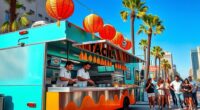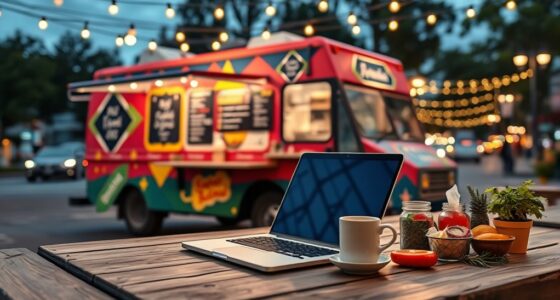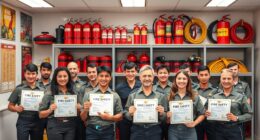To build an engaging food truck website, focus on creating a striking hero image with clear calls-to-action and bold colors that stand out. Showcase your brand identity with consistent visuals and a memorable logo. Present your menu with vivid descriptions and organize it for easy navigation. Incorporate real-time location updates, online ordering, and reviews to boost customer interaction. Optimize for local search and make sure your site is mobile-friendly. Keep exploring to discover how all these pieces come together seamlessly.
Key Takeaways
- Create a visually striking, mobile-responsive hero image with clear CTA buttons using contrasting colors to drive engagement.
- Showcase a consistent brand identity with high-quality images, a memorable logo, and a limited, cohesive color palette and fonts.
- Organize menu sections with vivid descriptions and highlight popular dishes to entice customers visually and sensorially.
- Integrate real-time location updates, schedules, and interactive maps to facilitate spontaneous visits and increase customer interaction.
- Optimize for local SEO with relevant keywords, claim your Google Business Profile, and encourage reviews to boost visibility.
Crafting a Visually Striking Hero Image

Creating a visually striking hero image is essential for capturing visitors’ attention and setting the tone for your food truck website. Your hero image should feature a clear call to action (CTA) that’s concise, compelling, and encourages immediate interaction. Use strong verbs and emotional language to boost engagement, and make sure your CTA stands out with bold colors that contrast against the background. Keep it visually balanced to avoid overwhelming visitors, guiding them naturally toward the next step. Make certain your hero image is fully responsive, adapting seamlessly across devices, with optimized file sizes for fast loading. Use composition techniques like the rule of thirds to direct focus and incorporate color contrast to highlight key elements. A well-crafted hero image engages visitors instantly, making them enthusiastic to explore more. Additionally, ensuring your hero image is optimized for fast load times can significantly improve user experience and reduce bounce rates. Incorporating visual hierarchy into your hero design helps prioritize important elements and guides viewer attention effectively.
Showcasing Your Brand Identity Effectively

To showcase your brand identity effectively, you need consistent visual elements across your website and truck. Use the same colors, fonts, and graphics to create a unified look that’s easy for customers to recognize. A memorable logo design also plays a vital role in building trust and reinforcing your brand’s presence both online and on the road. Incorporating these branding elements into your website design supports recognition and helps differentiate your food truck from competitors through visual branding strategies. Additionally, maintaining a cohesive online presence can improve your site’s performance cookies and overall user experience, making it easier for visitors to connect with your brand.
Consistent Visual Elements
Maintaining consistent visual elements across your food truck’s website is essential for building a strong and recognizable brand identity. Use a limited color palette that reflects your truck’s personality, evoking the right emotions and guaranteeing readability across devices. Align colors across your website, social media, and physical truck for a cohesive look. Choose no more than three fonts that embody your brand voice, maintaining hierarchy with size and weight variations. Use high-quality, authentic images with a uniform style—lighting, color grading, and composition—to build trust and showcase your offerings. Keep your layout consistent, with uniform buttons, icons, and spacing, and ensure mobile responsiveness. Incorporate social media links with matching brand colors, and regularly update visuals to reflect current menus and events. Mobile optimization is crucial, as restaurants are among the most searched industries on mobile devices, so your website must load quickly and be easily readable on smartphones and tablets. Additionally, consistent branding enhances user trust and encourages repeat visits.
Memorable Logo Design
A memorable logo is a powerful tool for showcasing your food truck’s brand identity and capturing customer attention. To do this effectively, incorporate food elements that highlight your signature dish or cuisine. Clear imagery helps customers instantly recognize what you offer, building emotional connections and supporting visual storytelling. Choose relevant, straightforward food icons instead of abstract symbols to avoid confusion. Use customized fonts that reflect your brand personality, ensuring they’re legible from a distance and on moving vehicles. Select vibrant colors related to your menu—like golden browns or fresh greens—to boost visibility and reinforce brand consistency. Utilization of Food Truck Logos Keep the design simple and scalable, so it remains clear across all sizes and platforms. In conclusion, craft a unique logo that reflects your values, helping your food truck stand out in a crowded market. Additionally, understanding the importance of visual branding strategies can further enhance your logo’s effectiveness in attracting and retaining customers.
Highlighting Your Menu With Clear Descriptions

Clear and enticing food descriptions are essential for guiding customers through your menu and encouraging orders. Use vivid language to highlight flavor, texture, and preparation, incorporating sensory words like crispy or tender to stimulate appetite. Mention unique ingredients or cooking styles to set your dishes apart. Keep descriptions brief but informative, avoiding jargon or confusing terms. Organized menu structure is key: divide items into categories like appetizers, mains, and desserts, keeping these sections concise to prevent overwhelm. Use easy-to-read fonts and large text sizes for visibility from a distance, especially on digital screens. Highlight popular or high-profit dishes by positioning them prominently and using color or visual cues to draw attention. Regularly update featured items based on seasonality and sales data to keep your menu fresh and engaging. Additionally, including visual cues such as icons or color coding can help customers quickly identify specials or dietary options, enhancing their overall experience. Incorporating menu layout best practices can also improve readability and customer satisfaction, leading to increased sales.
Incorporating Real-Time Location and Schedule Features

Showcasing your truck’s real-time location and schedule can substantially boost customer engagement and drive more foot traffic. By sharing live updates, you reduce customer uncertainty about where you are, encouraging spontaneous visits during busy events or pop-ups. This continuous communication fosters loyalty and builds a sense of community around your brand. Using GPS devices or apps like Glympse simplifies tracking and sharing your location seamlessly, linking updates to social media and your website for maximum reach. Embedding interactive maps or live tracking widgets makes it easy for customers to find you instantly. Additionally, combining location info with your schedule helps customers plan visits, while push notifications keep them informed about new stops or special events, making your truck more accessible and professional. Features of Food Truck Finder include the ability to share location links across social media platforms such as Facebook, Twitter, and Instagram, which further enhances your visibility and customer reach. Incorporating real-time location sharing with reliable GPS technology can also improve your operational efficiency and responsiveness.
Designing a User-Friendly and Mobile-Optimized Layout
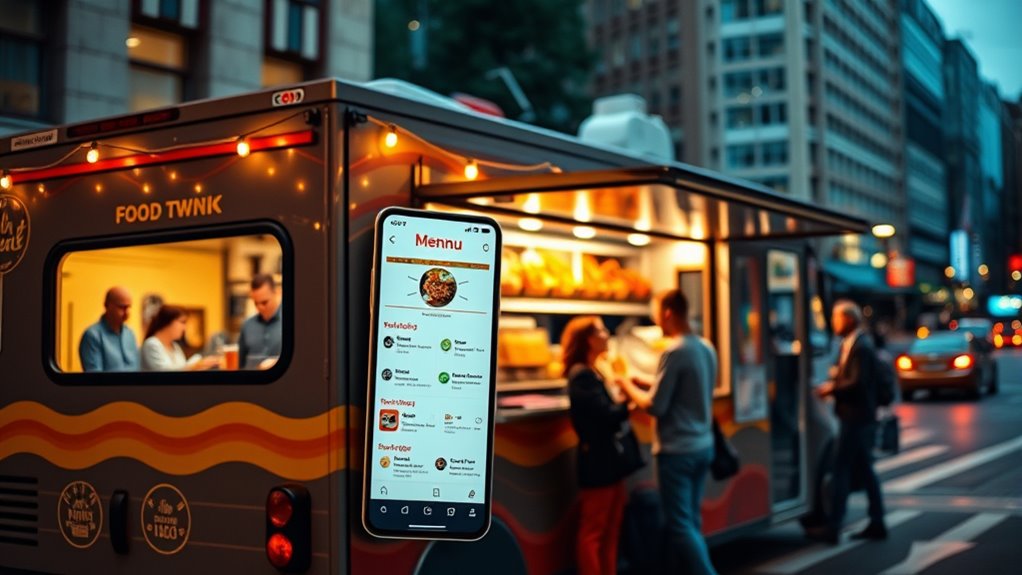
Creating a mobile-optimized layout is essential since most customers search for food trucks on their phones. Use responsive design to guarantee your site adapts seamlessly to all screen sizes, making it easy to navigate. Simplifying your menu and layout helps visitors find what they need quickly, boosting engagement and orders. Paying attention to user experience ensures your website remains accessible and attractive across various devices.
Responsive Design Best Practices
Designing a user-friendly and mobile-optimized food truck website starts with adopting a responsive design approach that adapts seamlessly to all screen sizes. You focus on creating a flexible layout that scales from smartphones to desktops without needing separate versions. Prioritize readable text, fast load times, and touch-friendly buttons to enhance user experience. Use clear visual hierarchy and simplified menus, so visitors can quickly find what they want. Keep images optimized for quick loading, maintaining sharpness across devices. Incorporate large, spaced buttons and links for easy tapping, especially for call-to-actions like ordering or directions. Maintain consistent branding with recognizable logos and colors, ensuring high-quality visuals look great everywhere. This approach guarantees your site is engaging, functional, and accessible to all potential customers. Responsive design ensures that your website provides a smooth, enjoyable experience regardless of the device used. Additionally, understanding asset division principles can help inform legal considerations for business owners in case of business dissolution or disputes.
Simplified Navigation Strategies
Simplified navigation is essential for providing a seamless user experience on your food truck website, especially on mobile devices. Organize menus with clear sections like “About Us,” “Menu,” “Locations,” and “Contact” to make browsing straightforward. Use hierarchical grouping, such as appetizers, mains, and desserts, to help visitors find what they want quickly. Highlight the current page with visual cues like bold text or breadcrumbs to keep users oriented. Keep navigation concise, focusing on primary actions and essential information. Use mobile-friendly elements like hamburger menus or collapsible sections to save space. Test on various devices to guarantee buttons are tappable and interactions are smooth. Clear calls-to-action and easy-to-use forms ensure visitors can order, contact, or navigate effortlessly. Incorporating user privacy and cookies management features can build trust and enhance the browsing experience.
Integrating Online Ordering and Payment Options
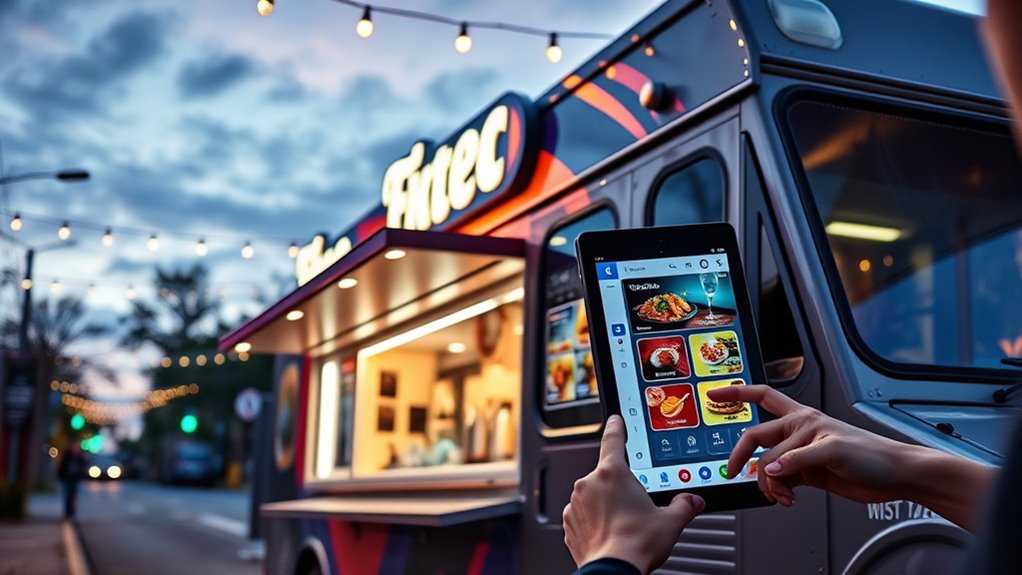
Integrating online ordering and payment options into your food truck’s website can considerably boost efficiency and customer satisfaction. You’ll streamline sales, reduce admin work, and allow customers to order remotely with ease. You’ll also be able to offer nutrient-rich ingredients and healthier options, which can attract more health-conscious customers. They can select pickup times, avoiding queues and wait times, and customize orders digitally for accuracy. Real-time menu updates ensure orders reflect current availability, preventing disappointment. Visualize customers browsing your menu, choosing their favorites, and paying securely with a credit card or mobile wallet—contactless options included. Advanced integrations enable seamless synchronization with your inventory and POS systems, further improving operational efficiency. Customers browsing your menu anytime, anywhere, and choosing pickup times that fit their schedule. Seeing real-time updates on item availability. Paying securely with multiple digital options. Avoiding long lines and wait times altogether.
Leveraging Social Media and Customer Reviews for Engagement
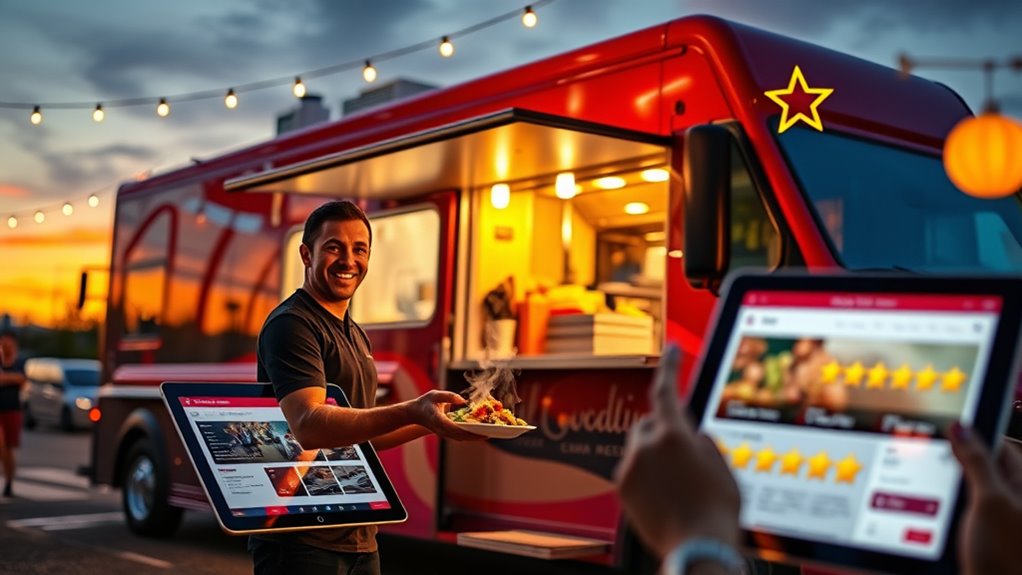
Have you ever wondered how social media can transform your food truck’s customer engagement? With 68% of owners using platforms regularly, it’s a powerful tool. Facebook dominates, with 75% of trucks active there, serving as a review hub and info source. Instagram and TikTok focus on visual storytelling, helping you showcase your unique offerings and attract younger customers. Short-form videos and viral challenges boost engagement by up to 60%. Over 74% of diners discover trucks through social media, often influenced by user-generated content, which accounts for 62% of engagement. Responding promptly to reviews builds loyalty and trust, turning customers into brand advocates. Investing in social media campaigns, which cost $200–$500 weekly, can immensely increase foot traffic and sales, making your online presence essential for success. Social media marketing effectiveness increases by 30% when campaigns are tailored to seasonal and holiday themes, further boosting customer engagement.
Optimizing for Local Search and SEO Strategies
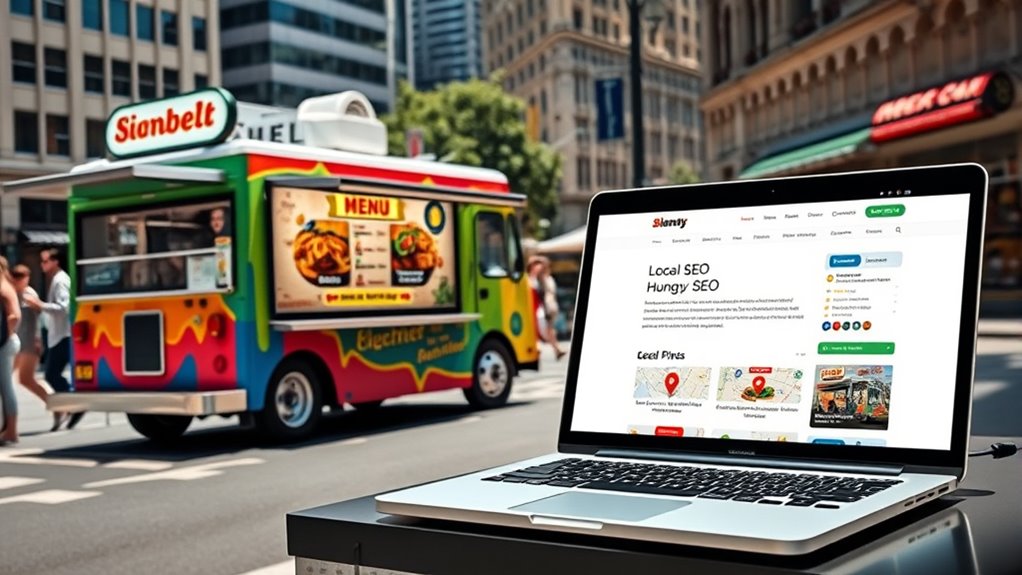
To attract more local customers, optimizing your food truck’s online presence for search engines is essential. Focus on keyword research using tools like Moz, Google AdWords, and SEMrush to find relevant local terms. Use primary keywords like “food truck tacos” and secondary ones such as “gluten-free vegan desserts” in your website’s text, titles, meta descriptions, headers, and image filenames—descriptive filenames like “pulled-pork-sandwich-kansas-city.jpg” help search engines index your images. Keep your site mobile-friendly, fast-loading, and accessible, with responsive design and optimized images. Claim and update your Google Business Profile regularly, encouraging reviews and posting specials. List your truck on local directories, maintaining consistent NAP info, and add rich content to boost your local search visibility. Over 77% of Americans had smartphones as of early 2018, making a mobile-friendly website crucial for reaching your audience effectively.
Ensuring Durability and Visibility of Branding Elements
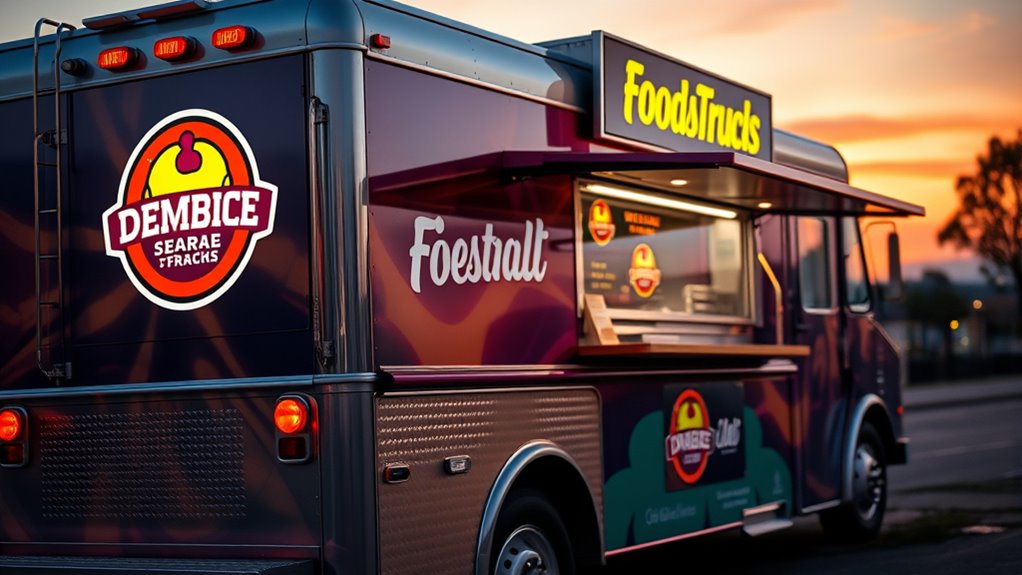
Ensuring that your food truck’s branding remains eye-catching and intact requires selecting high-quality, weather-resistant materials for all exterior graphics. Use durable vinyl wraps, decals, and protective laminates to withstand sun, rain, and abrasion. Regular maintenance like cleaning and quick repairs keep branding fresh, reinforcing trust. To improve visibility, choose bold, high-contrast colors, and place large logos on multiple sides. Incorporate LED lighting or backlit signs for night or poor weather conditions. Consider this table for clarity:
| Strategy | Details |
|---|---|
| Weather-Resistant Graphics | Vinyl wraps, laminates, sturdy packaging |
| Visibility Enhancers | High-contrast colors, backlit signs |
| Maintenance & Consistency | Regular cleaning, uniform branding |
This approach guarantees your brand remains prominent and durable over time. Effective branding strategies ensure long-term recognition and customer recall.
Frequently Asked Questions
How Can I Ensure My Website Loads Quickly on Mobile Devices?
To guarantee your website loads quickly on mobile devices, you should optimize images with modern formats like WebP and AVIF, and implement lazy loading so content loads only when needed. Minify and combine your CSS, JavaScript, and HTML files to reduce requests. Use browser caching and a CDN to deliver content faster. Make sure your design is responsive, touch-friendly, and prioritizes essential information for a smooth, quick user experience.
What Are the Best Practices for Integrating Online Ordering Securely?
Think of your online ordering system as a secure vault protecting your customers’ data. To keep it safe, choose trusted software with strong encryption and guarantee PCI DSS compliance. Always use HTTPS for data transfer, regularly update your software, and employ secure login controls. These steps create a digital fortress that safeguards transactions, builds customer trust, and keeps your food truck running smoothly without security breaches.
How Do I Choose the Most Effective Colors and Fonts for My Brand?
You want to pick colors and fonts that truly represent your brand and attract customers. Focus on colors like red and yellow to stimulate appetite and grab attention, but choose shades that match your gourmet or health-focused image. Use fonts that are clear and reflect your vibe—bold for fun, simple for premium. Keep it consistent, limit your font choices, and guarantee high contrast for readability. This boosts recognition and creates a memorable brand.
What Tools Can I Use to Embed a Live Location Map Easily?
To embed a live location map easily, you can use simple tools like Google Maps iframe codes, Google Maps Embed API, or third-party plugins like Agile Store Locator and Mapme. These tools let you add interactive maps, static images, or store locators quickly and with minimal coding. They guarantee responsiveness, enhance usability, and help visitors find locations effortlessly, making your website more engaging and user-friendly.
How Can I Encourage More Customer Reviews on My Site?
To encourage more customer reviews on your site, make the process simple and convenient. Use one-click or minimal-step review forms, and promote them through pop-ups and banners after orders or events. Offer incentives like discounts or freebies, and respond promptly to all reviews to show you value feedback. Educate customers on the importance of reviews, and leverage social media to motivate sharing. Highlight reviews to build trust and community around your food truck.
Conclusion
By creating an engaging food truck website, you’ll attract more customers and boost your sales. Remember, 78% of mobile searches lead to offline purchases, so a mobile-optimized site is essential. Incorporate eye-catching visuals, clear menus, and real-time updates to keep visitors interested. With a strong online presence, you’ll build loyalty and stand out in your local community. Stay consistent, prioritize user experience, and watch your food truck thrive.

